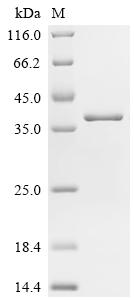Recombinant Human Charged multivesicular body protein 2b (CHMP2B)
CAT:
399-CSB-EP891990HUc7-02
Size:
100 µg
Price:
Ask
- Availability: 24/48H Stock Items & 2 to 6 Weeks non Stock Items.
- Dry Ice Shipment: No




Recombinant Human Charged multivesicular body protein 2b (CHMP2B)
- CAS Number: 9000-83-3
- Gene Name: CHMP2B
- UniProt: Q9UQN3
- Expression Region: 2-213aa
- Organism: Homo sapiens
- Target Sequence: ASLFKKKTVDDVIKEQNRELRGTQRAIIRDRAALEKQEKQLELEIKKMAKIGNKEACKVLAKQLVHLRKQKTRTFAVSSKVTSMSTQTKVMNSQMKMAGAMSTTAKTMQAVNKKMDPQKTLQTMQNFQKENMKMEMTEEMINDTLDDIFDGSDDEEESQDIVNQVLDEIGIEISGKMAKAPSAARSLPSASTSKATISDEEIERQLKALGVD
- Tag: C-terminal 6xHis-tagged
- Source: E.coli
- Field of Research: Signal Transduction
- Assay Type: Developed Protein
- Relevance: Probable core component of the endosomal sorting required for transport complex III (ESCRT-III) which is involved in multivesicular bodies (MVBs) formation and sorting of endosomal cargo proteins into MVBs. MVBs contain intraluminal vesicles (ILVs) that are generated by invagination and scission from the limiting membrane of the endosome and mostly are delivered to lysosomes enabling degradation of membrane proteins, such as stimulated growth factor receptors, lysosomal enzymes and lipids. The MVB pathway appears to require the sequential function of ESCRT-O, -I, -II and -III complexes. ESCRT-III proteins mostly dissociate from the invaginating membrane before the ILV is released. The ESCRT machinery also functions in topologically equivalent membrane fission events, such as the terminal stages of cytokinesis and the budding of enveloped viruses (HIV-1 and other lentiviruses). ESCRT-III proteins are believed to mediate the necessary vesicle extrusion and/or membrane fission activities, possibly in conjunction with the AAA ATPase VPS4.
- Purity: Greater than 90% as determined by SDS-PAGE.
- Activity: Not Test
- Length: Full Length of Mature Protein
- Form: Liquid or Lyophilized powder
- Buffer: If the delivery form is liquid, the default storage buffer is Tris/PBS-based buffer, 5%-50% glycerol. If the delivery form is lyophilized powder, the buffer before lyophilization is Tris/PBS-based buffer, 6% Trehalose, pH 8.0.
- Reconstitution: We recommend that this vial be briefly centrifuged prior to opening to bring the contents to the bottom. Please reconstitute protein in deionized sterile water to a concentration of 0.1-1.0 mg/mL.We recommend to add 5-50% of glycerol (final concentration) and aliquot for long-term storage at -20℃/-80℃. Our default final concentration of glycerol is 50%. Customers could use it as reference.
- Molecular Weight: 30.7 kDa
- Storage Conditions: The shelf life is related to many factors, storage state, buffer ingredients, storage temperature and the stability of the protein itself. Generally, the shelf life of liquid form is 6 months at -20℃/-80℃. The shelf life of lyophilized form is 12 months at -20℃/-80℃.
